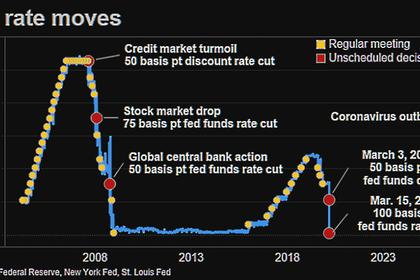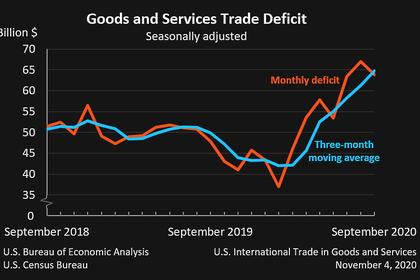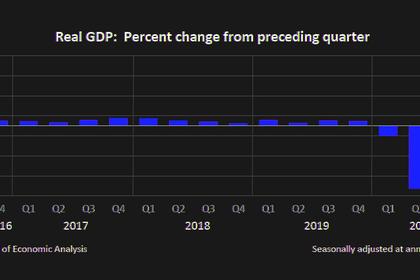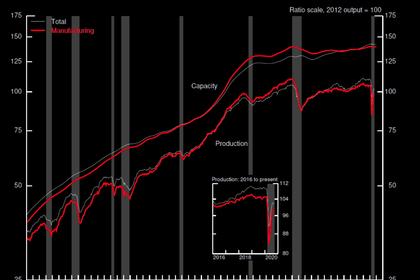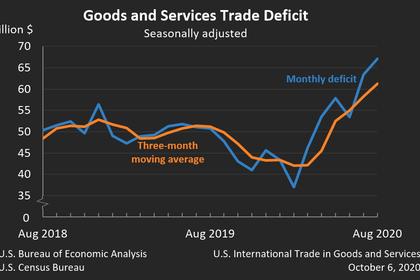
U.S. UNEMPLOYMENT DOWN TO 6.9%
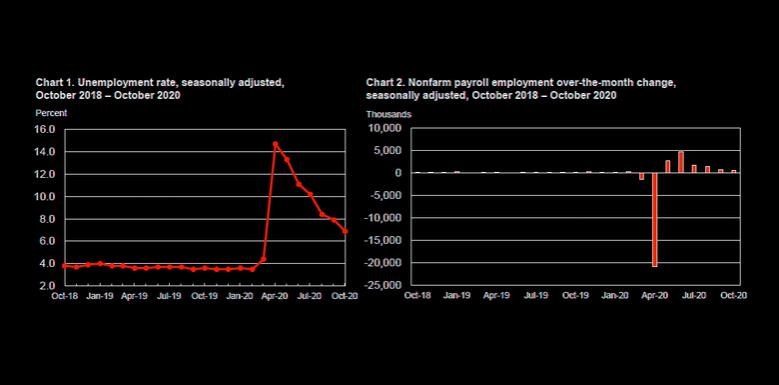
U.S. BLS - Friday, November 6, 2020 - THE EMPLOYMENT SITUATION -- OCTOBER 2020
Total nonfarm payroll employment rose by 638,000 in October, and the unemployment rate declined to 6.9 percent, the U.S. Bureau of Labor Statistics reported today. These improvements in the labor market reflect the continued resumption of economic activity that had been curtailed due to the coronavirus (COVID-19) pandemic and efforts to contain it. In October, notable job gains occurred in leisure and hospitality, professional and business services, retail trade, and construction. Employment in government declined.
This news release presents statistics from two monthly surveys. The household survey measures labor force status, including unemployment, by demographic characteristics. The establishment survey measures nonfarm employment, hours, and earnings by industry. For more information about the concepts and statistical methodology used in these two surveys, see the Technical Note.
Household Survey Data
In October, the unemployment rate declined by 1.0 percentage point to 6.9 percent, and the number of unemployed persons fell by 1.5 million to 11.1 million. Both measures have declined for 6 consecutive months but are nearly twice their February levels (3.5 percent and 5.8 million, respectively). (See table A-1. For more information about how the household survey and its measures were affected by the coronavirus pandemic, see the box note at the end of this news release.)
Unemployment rates declined among all major worker groups in October. The rate was 6.7 percent for adult men, 6.5 percent for adult women, 13.9 percent for teenagers, 6.0 percent for Whites, 10.8 percent for Blacks, 7.6 percent for Asians, and 8.8 percent for Hispanics. (See tables A-1, A-2, and A-3.)
Among the unemployed, the number of persons on temporary layoff fell by 1.4 million to 3.2 million. This measure is down considerably from the high of 18.1 million in April but is 2.4 million higher than in February. The number of permanent job losers, at 3.7 million in October, changed little over the month but is 2.4 million higher than in February. (See table A-11.)
In October, the number of long-term unemployed (those jobless for 27 weeks or more) increased by 1.2 million to 3.6 million, accounting for 32.5 percent of the total unemployed. By contrast, the number of unemployed persons jobless 15 to 26 weeks decreased by 2.3 million to 2.6 million, and the number of persons jobless 5 to 14 weeks decreased by 457,000 to 2.3 million. The number of persons who were jobless less than 5 weeks was about unchanged at 2.5 million. (See table A-12.)
The labor force participation rate increased by 0.3 percentage point to 61.7 percent in October; this is 1.7 percentage points below the February level. The employment-population ratio increased by 0.8 percentage point to 57.4 percent in October but is 3.7 percentage points lower than in February. (See table A-1.)
In October, the number of persons who usually work full time rose by 1.2 million to 123.6 million, and the number who usually work part time increased by 1.0 million to 26.2 million. (See table A-9.)
The number of persons employed part time for economic reasons increased by 383,000 to 6.7 million in October, after declines totaling 4.6 million over the prior 5 months. These individuals, who would have preferred full-time employment, were working part time because their hours had been reduced or they were unable to find full-time jobs. This group includes persons who usually work full time and persons who usually work part time. (See table A-8.)
The number of persons not in the labor force who currently want a job decreased by 539,000 to 6.7 million in October; this measure is 1.7 million higher than in February. These individuals were not counted as unemployed because they were not actively looking for work during the last 4 weeks or were unavailable to take a job. (See table A-1.)
Among those not in the labor force who currently want a job, the number of persons marginally attached to the labor force, at 2.0 million, was about unchanged in October. These individuals were not in the labor force, wanted and were available for work, and had looked for a job sometime in the prior 12 months but had not looked for work in the 4 weeks preceding the survey. The number of discouraged workers, a subset of the marginally attached who believed that no jobs were available for them, was 588,000 in October, essentially unchanged from the previous month. (See Summary table A.)
Household Survey Supplemental Data
In October, 21.2 percent of employed persons teleworked because of the coronavirus pandemic, down from 22.7 percent in September. These data refer to employed persons who teleworked or worked at home for pay at some point in the last 4 weeks specifically because of the pandemic.
In October, 15.1 million persons reported that they had been unable to work because their employer closed or lost business due to the pandemic--that is, they did not work at all or worked fewer hours at some point in the last 4 weeks due to the pandemic. This measure is down from 19.4 million in September. Among those who reported in October that they were unable to work because of pandemic- related closures or lost business, 11.7 percent received at least some pay from their employer for the hours not worked, up from 10.3 percent in September.
About 3.6 million persons not in the labor force in October were prevented from looking for work due to the pandemic. This is down from 4.5 million in September. (To be counted as unemployed, by definition, individuals must either be actively looking for work or on temporary layoff.)
These supplemental data come from questions added to the household survey beginning in May to help gauge the effects of the pandemic on the labor market. The data are not seasonally adjusted. Tables with estimates from the supplemental questions for all months are available online at www.bls.gov/cps/effects-of-the-coronavirus-covid-19-pandemic.htm.
Establishment Survey Data
Total nonfarm payroll employment rose by 638,000 in October and has increased for 6 consecutive months. In October, nonfarm employment was below its February level by 10.1 million, or 6.6 percent. Notable job gains occurred over the month in leisure and hospitality, professional and business services, retail trade, and construction. Employment in government declined. (See table B-1. For more information about how the establishment survey and its measures were affected by the coronavirus pandemic, see the box note at the end of this news release.)
Employment in leisure and hospitality increased by 271,000 in October, with gains in food services and drinking places (+192,000); arts, entertainment, and recreation (+44,000); and accommodation (+34,000). Leisure and hospitality has added 4.8 million jobs since April, but employment in the industry is down by 3.5 million since February.
Professional and business services added 208,000 jobs in October, with temporary help services (+109,000) accounting for about half of the gain. Employment also increased in services to buildings and dwellings (+19,000), computer systems design and related services (+16,000), and management and technical consulting services (+15,000). Employment in professional and business services is 1.1 million below its February level.
In October, retail trade added 104,000 jobs, with almost one-third of the gain in electronics and appliance stores (+31,000). Employment also rose in motor vehicle and parts dealers (+23,000), furniture and home furnishings stores (+14,000), clothing and clothing accessories stores (+13,000), general merchandise stores (+10,000), and nonstore retailers (+9,000). Employment in retail trade has risen by 1.9 million since April but is 499,000 below its February level.
Construction added 84,000 jobs in October. Specialty trade contractors added jobs, both in the nonresidential (+28,000) and residential (+18,000) components. Employment also rose in heavy and civil engineering construction and in construction of buildings (+19,000 each). Construction has added 789,000 jobs in the last 6 months, but employment is down by 294,000 since February.
Employment in health care and social assistance rose by 79,000 in October but is down by 950,000 since February. In October, health care employment increased by 58,000, with the largest gains occurring in hospitals (+16,000), offices of physicians (+14,000), offices of dentists (+11,000), and outpatient care centers (+10,000). These increases were partially offset by a decline of 9,000 in nursing and residential care facilities. Social assistance added 21,000 jobs over the month.
Employment in transportation and warehousing increased by 63,000 in October, with gains occurring in warehousing and storage (+28,000), transit and ground passenger transportation (+25,000), and truck transportation (+10,000). By contrast, air transportation shed 18,000 jobs. Employment in transportation and warehousing is 271,000 below its February level.
The other services industry added 47,000 jobs in October, with gains occurring in personal and laundry services (+27,000) and in repair and maintenance (+18,000). Employment in other services is 436,000 below its February level.
Manufacturing employment rose by 38,000 in October but is 621,000 lower than in February. Gains occurred in fabricated metal products (+7,000), primary metals (+6,000), and wood products (+4,000). Employment continued to trend up in food manufacturing (+6,000) and in plastics and rubber products (+4,000).
Employment in financial activities rose by 31,000 in October but is 129,000 lower than in February. Over-the-month job gains occurred in finance and insurance (+17,000) and real estate (+10,000).
In October, government employment fell by 268,000. A decrease of 138,000 in federal government was driven by a loss of 147,000 temporary 2020 Census workers.
Job losses also occurred in local government education and state government education (-98,000 and -61,000, respectively).
Employment in other major industries, including mining, wholesale trade, and information, changed little in October.
In October, average hourly earnings for all employees on private nonfarm payrolls increased by 4 cents to $29.50. Average hourly earnings of private-sector production and nonsupervisory employees rose by 5 cents to $24.82. The large employment fluctuations over the past several months--especially in industries with lower-paid workers--complicate the analysis of recent trends in average hourly earnings. (See tables B-3 and B-8.)
The average workweek for all employees on private nonfarm payrolls was unchanged at 34.8 hours in October. In manufacturing, the workweek increased by 0.3 hour to 40.5 hours, and overtime rose by 0.2 hour to 3.2 hours. The average workweek for production and nonsupervisory employees increased by 0.1 hour to 34.2 hours. (See tables B-2 and B-7.)
The change in total nonfarm payroll employment for August was revised up by 4,000 from +1,489,000 to +1,493,000, and the change for September was revised up by 11,000 from +661,000 to +672,000. With these revisions, employment in August and September combined was 15,000 higher than previously reported. (Monthly revisions result from additional reports received from businesses and government agencies since the last published estimates and from the recalculation of seasonal factors.)
-----
Earlier:
